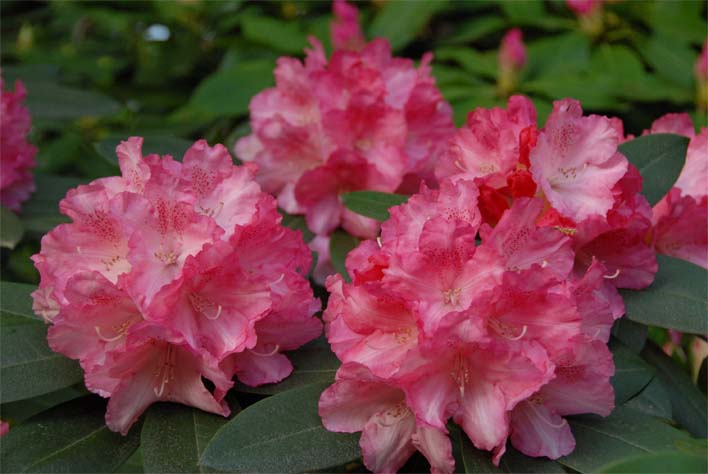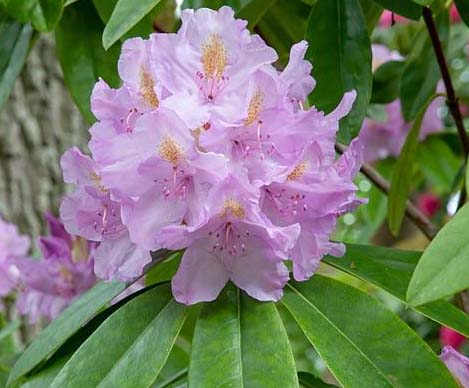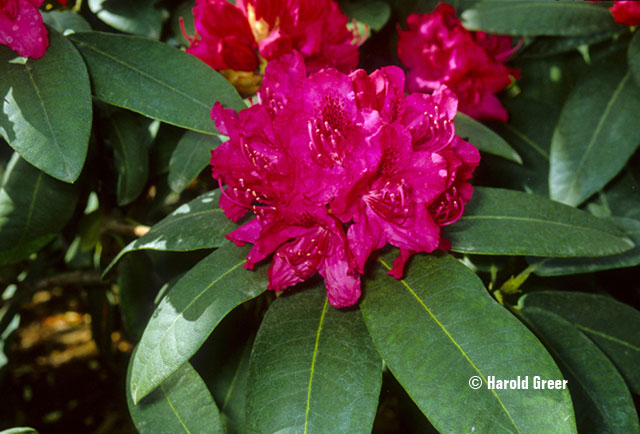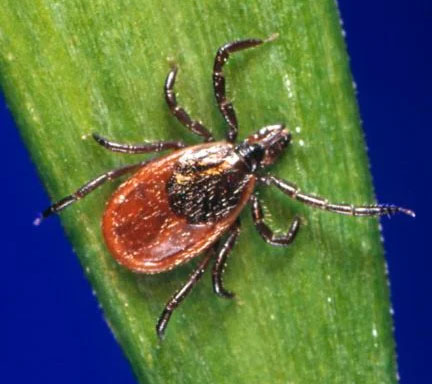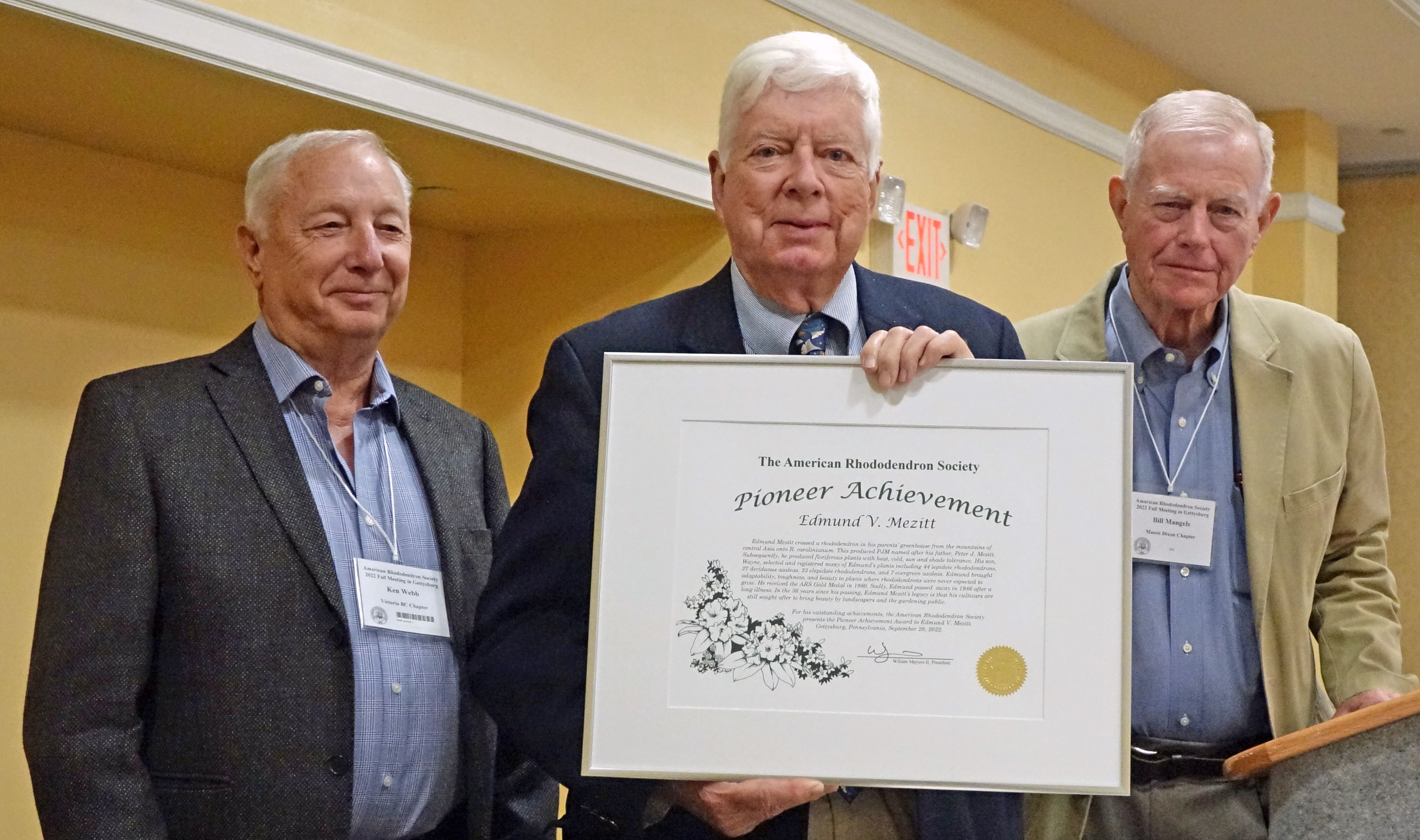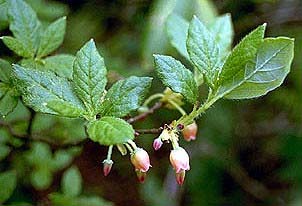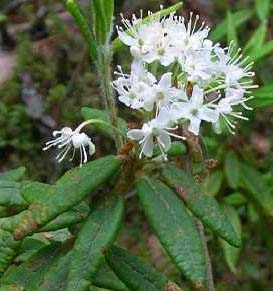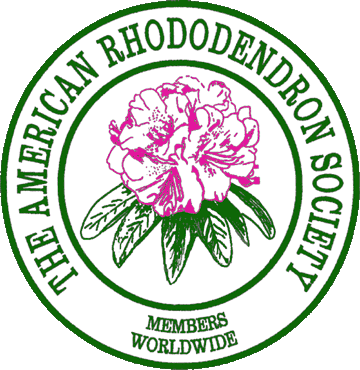|
The Blog - Random Contributions by Members
Blog Index
• Ironclads brave heat and drought
• Rhododendron 'Tony', a Shammarello hybrid
• Fatal Tick-borne Disease: Babesiosis
• OpenAI on Rhododendrons & Azaleas
• Hank Schannen
His Wit & Wisdom
Ironclads brave heat and drought Philadelphia just set a record that can't be broken. October 2024 was the driest month in Philadelphia recorded meteorological history - no measurable rain. None, zippo, zero, nada, nil. (The only way to beat such a record is if climate change goes turbo and results in negative rain. You know, when lots of drops come out of the ground and go straight up into the atmosphere. Just saying.) It turns out that many of the cultivars they cite are among the so-called "ironclads" and/or have species native to Eastern North America in their parentage. Indeed, ironclads for the most part are hybrids of R. maximum, catawbiense or carolinianum. In a serendipitous bit of timing, the chapter's October, 2024, meeting featured Steven Kristoph, nurseryman and college instructor from central New Jersey, whose topic was ironclads. These hybrids were first described in the nineteen-teens, with lists from E. H. Wilson and Cornell's Ralph Curtis. The point was to identify rhododendrons that would survive the winters of the northeastern United States, given that so many cultivars from England died or were grimly set back when America's deep freeze winters locked in.
Here are some other takeaways from the Journal articles and Steve's presentation summarized by Michael Martin Mills: To return to top Click Here.
References:
"This has been more than just a dry spell" by Michael Martin Mills in the DVRS Autumn 2024 Rhodogravure
Rhododendron 'Tony' The devastating winter of 1938 in South Euclid, Ohio, induced Tony Shammarello to begin hybridizing. Ninety percent of the rhododendrons in the Shammarello field were devastated. Tony thought that, while he was at it, he might as well aim at producing rhododendron hybrids heavily foliaged and of modest stature. In 1943 Tony Shammarello crossed 'Boule de Niege' with a selected red catawbiense and after several years of selection introduced the plant in the illustration and named it 'Tony'. His primary objective was to obtain a dwarf red, which he certainly achieved. The bright cherry red trusses are at their best in late May and are bud hardy to -20 degrees F. The leaves are 4" long and 1¾" wide, thick dark green and slightly crinkled. The plant habit is extremely sturdy and compact. Sadly, Tony Shammarello passed away in 1982, but his many rhododendron hybrids including 'Tony' survive him. Through the years, the rhododendron 'Tony' has been overlooked to a large extent. Recently, Mike Stewart sent rooted cutting to many nurseries in areas around the US to evaluate as commercial plants In field trials they ran. The one rhododendron that was most frequently admired was 'Tony,' the Shammarello hybrid. R. 'Tony' has a good compact plant habit, lush dark green foliage, and tolerance to sun, shade, heat, and cold. Grows to a height of about 4 feet in 10 years, making it a relatively compact shrub with dense foliage suitable for the suburban landscape. The foliage provides year-round interest, even when the plant isn't in bloom. Tolerance of cold temperatures down to -15°F (-26°C), makes it suitable for many climates. It prefers partial shade but can tolerate more sun if it has adequate moisture. It can be planted as an accent in borders and foundation plantings and adds a focal point to any landscape. As a bonus, it attracts bees, making it a valuable addition to pollinator gardens. Overall, Rhododendron 'Tony' is a fantastic choice for gardeners who want a vibrant and low-maintenance shrub that adds beauty to their landscape. Its striking red flowers and attractive foliage make it a standout plant that will surely be admired by all who see it. Now, the efforts of Mike Stewart, Van Veen Nursery, and the American Rhododendron Society will make sure it is available to rhododendron nurseries around the US. To return to top Click Here.
References:
"Rhododendron Tony" by Alfred Martin in the QBARS: V25N2, 1971
Fatal Tick-borne Disease: Babesiosis Recently, the horticulture community mourned the loss of Wayne Mezitt, a renowned horticulturist, who passed away due to complications from babesiosis. But what is babesiosis. Babesiosis is a tick-borne disease that has been gaining attention due to its increasing incidence and potential severity. Transmission of BabesiosisBabesiosis is primarily transmitted through the bite of an infected black-legged tick (Ixodes scapularis), commonly known as the deer tick. These ticks are most prevalent in the Northeastern and Upper Midwestern United States. The disease can also be transmitted through blood transfusions, organ transplants, and from mother to baby during pregnancy or delivery, although these modes of transmission are less common. The causative agent of babesiosis is a microscopic parasite called Babesia, which infects red blood cells. The most common species causing human babesiosis in the United States is Babesia microti. Recognizing Babesiosis
The symptoms of babesiosis can vary widely, ranging from mild to severe. Some people may remain asymptomatic, especially if they are otherwise healthy. However, in others, particularly those with compromised immune systems, the elderly, or individuals with underlying health conditions, the symptoms can be severe and potentially life-threatening. Complications of Babesiosis
Babesiosis can lead to several serious complications, particularly in high-risk individuals. These complications include: acute respiratory distress syndrome (ARDS),
disseminated intravascular coagulation (DIC) which can lead to widespread clotting and bleeding, heart failure, kidney failure, and splenic rupture. Prevention and Awareness
Preventing babesiosis primarily involves reducing the risk of tick bites. This can be achieved by: To return to top Click Here.
References:
CDC: Neurologic Complications of Babesiosis
Wayne Mezitt: 1942-2024
Wayne Mezitt of Hopkinton, MA, passed away on July 18, 2024. He was a revered figure in the horticulture industry and a dedicated champion of the genus Rhododendron. Wayne's contributions have left an indelible mark on our gardens, our hearts, and the very fabric of horticulture itself. To return to top Click Here.
References:
Weston Nursery Statement
OpenAI on Rhododendrons & Azaleas I asked Open AI artificial intelligence about growing rhododendrons and azaleas in the Philadelphia region. The first answer included using Aluminum Sulfate which is toxic to rhododendrons and azaleas after repeated applications. When informed of that, it thanked me and revised its post. Here is what OpenAI came up with. It is good for the most part. Climate ConsiderationsHardiness Zone: The Philadelphia region falls in USDA Hardiness Zones 7a to 7b. Rhododendrons and azaleas generally thrive in these zones, but it's essential to choose varieties that are well-suited to this range. Temperature Extremes: Be prepared for cold winters and hot, humid summers. Winter protection might be necessary for less hardy varieties. Soil RequirementsAcidic Soil: Both rhododendrons and azaleas prefer acidic soil with a pH between 4.5 and 6.0. Philadelphia’s native soil can vary, so it’s crucial to test the soil pH and amend it if necessary. Elemental sulfur or iron sulfate can be used to lower the pH safely. Well-Drained Soil: These plants do not tolerate waterlogged soil. Ensure the planting site has good drainage to prevent root rot. Raised beds or amended soil with organic matter like peat moss can help improve drainage. Planting and CareLocation: Choose a location with dappled shade. While they need some sunlight for blooms, too much direct sun can cause leaf scorch, especially during the hottest parts of the day. Mulching: Mulch around the plants to conserve moisture, regulate soil temperature, and prevent weeds. Use organic mulch like pine needles, wood chips, or bark. Watering: Keep the soil consistently moist but not waterlogged. During dry spells, deep watering is necessary. Ensure that the water reaches the root zone. FertilizationAcidic Fertilizers: Use fertilizers formulated for acid-loving plants. Avoid high-nitrogen fertilizers that can promote leaf growth at the expense of flowers. Timing: Fertilize in early spring before new growth begins and again after flowering. Avoid late-summer fertilization, which can promote new growth that might not harden off before winter. Pests and DiseasesCommon Pests: Be vigilant for pests such as lace bugs, which can damage foliage. Neem oil or insecticidal soap can help manage these pests. Disease Prevention: Proper spacing and good air circulation can help prevent fungal diseases like powdery mildew and root rot. Avoid overhead watering to minimize fungal issues. Winter ProtectionMulching and Burlap Wraps: Apply a thick layer of mulch in late fall to insulate the roots. For less hardy varieties, consider using burlap wraps to protect them from harsh winter winds and cold. PruningTiming: Prune immediately after flowering to shape the plant and remove dead or diseased wood. This timing ensures that you don’t remove next year’s flower buds. Technique: Light pruning is generally sufficient. Avoid heavy pruning, which can stress the plants and reduce blooming. Specific VarietiesLocal Recommendations: Consult local nurseries or extension services for recommended varieties that perform well in the Philadelphia region. Native or locally adapted species often have better resistance to local pests and diseases. Gardeners in the Philadelphia region can successfully grow beautiful rhododendrons and azaleas, enhancing their landscapes with these vibrant, flowering shrubs. To return to top Click Here.
References: Contributed by Steve Henning, May 26, 2024 Hank Schannen, His Wit & Wisdom 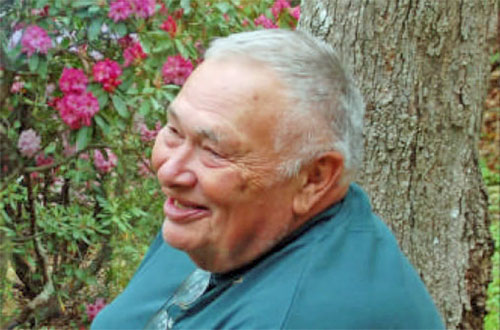 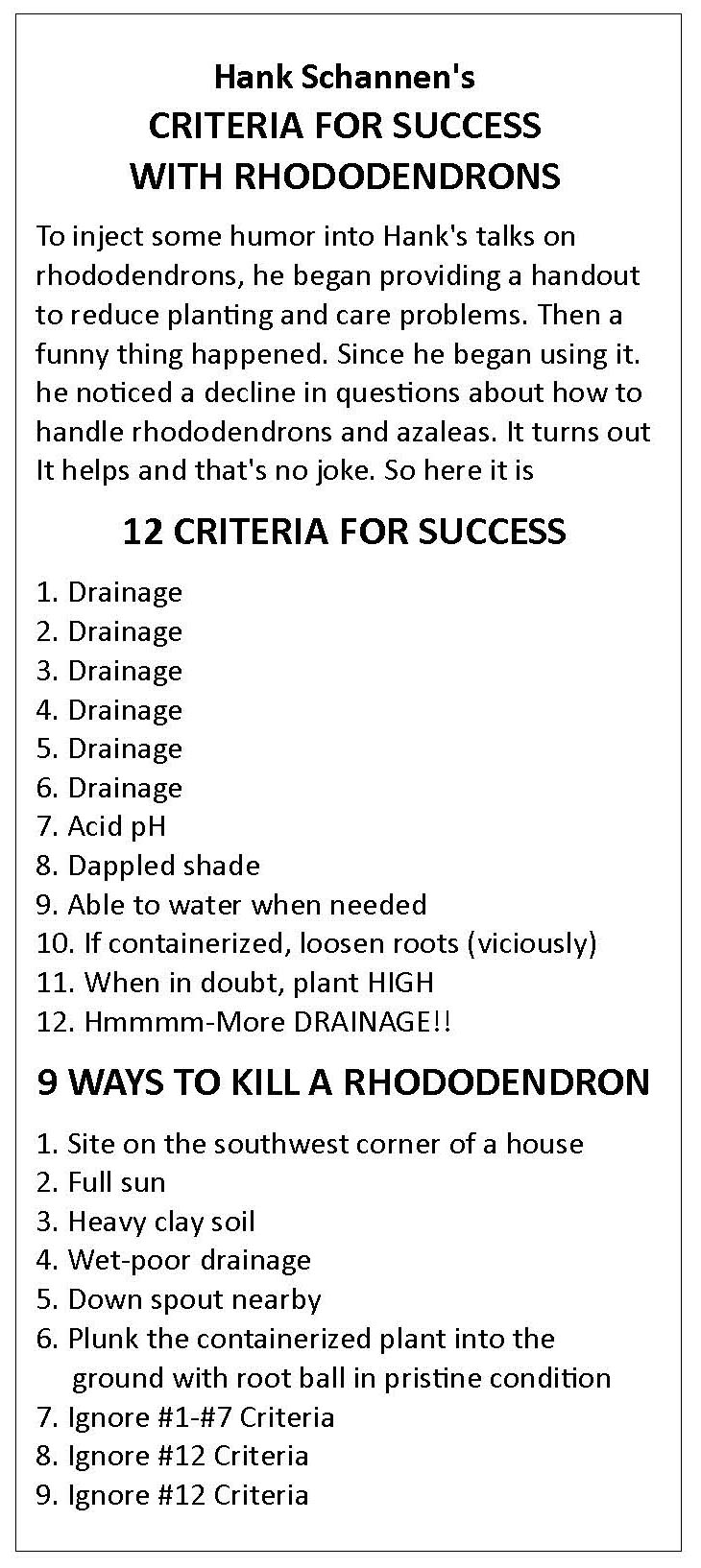
Sadly, 15 years ago Hank Schannen passed away on September 16, 2009, at the age of 71. He had joined the ARS Princeton Chapter 43 years earlier in 1966. Hank’s enthusiasm for rhododendrons combined with his gregarious personality led him to visit rhododendron hybridizers as far away as the West Coast and Germany. Hank became a popular speaker not only for his knowledge and photography, but also for his down-to-earth humor. To return to top Click Here.
References: Contributed by Steve Henning, April 1, 2024 The Newest Rhododendrons & The Natives 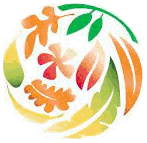
Currently there are 1,159 distinct Rhododendron species officially recognized. But, who decides which plants are the members of genus Rhododendron? It turns out that taxonomists and botanists publish their research and propose changes in classifications, hence names. Then an official body, the International Botanical Congresses, a collaboration between The Royal Botanic Gardens, Kew; The Harvard University Herbaria; and The Australian National Herbarium, meets every five years to update the official list. That is the International Plant Names Index (IPNI).
According to the USDA Plant List, these are the rhododendron species native to Pennsylvania, New Jersey, Delaware, or Maryland:
References: Researched by Steve Henning, August 12, 2023 To return to top Click Here. |

